强调句型重点用法例析
强调句型考点解读

强调句型考点解读强调句型是高中英语中一个重要的语法项目,是高考重要考点之一。
其基本结构为:It + be+ 被强调部分+that+句子其余部分。
本文拟结合高考试题对强调句型的用法作如下归纳。
一、基本用法1.在强调句型中,能够被强调的句子成分通常为主语、宾语、状语等,不能用来强调谓语动词、表语、补语、让步状语、条件状语等。
当被强调部分为sb.,且在句中作主语时,可用who,也可用that,其它情况一律用that。
强调主语时,that后的谓语动词必须与被强调的主语人称与数保持一致。
如:I’m going to meet my friend at the airport tomorrow.→It is I who am going to meet my friend at the airport tomorrow.(强调主语)It is my friend that I’m going to meet at the airport tomorrow.(强调宾语)It is at the airport that I’m going to meet my friend tomorrow.(强调地点状语)It is tomorrow that I’m going to meet my friend at the airport.(强调时间状语)2.在强调结构中,无论被强调的是人还是物,单数还是复数,be动词一律用单数is/was形式。
如果原句的谓语动词时态是过去范畴,就用was; 如果原句的谓语动词时态是现在范畴,就用is。
也可以用"情态动词+be"形式。
例如:It is Tom and Mary who will be fined.It was yesterday that he arrived here.It might be in the morning that he broke into the house.二、考点解读1.强调句型的一般疑问句结构为:“Is /Was it+ 被强调部分+that+句子其余部分?”例1.Was it during the Second World War ____ he died? (MET88)A. thatB. whileC. in whichD. then解析:此句为强调句的一般疑问句。
强调句型考点透析

强调句型考点透析强调句型是英语中的一种重要的句子结构,它是英语学习者必须掌握的一种重点句型,因而在高考英语试卷上占有一席之地。
在高中教材及练习中同学们见到时总会出现这样或那样的问题,本文拟结合高考试题对强调句型的各个主要方面作一归纳。
一.基本结构。
强调句型的基本结构是:”It is/was+被强调部分+that/who+其它成分”.它可以对除谓语以外的成分进行强调。
It is what you do rather than what you say that matters. (强调主语)It is my daughter who/that/whom I feel proud of. (强调宾语)It was only when I reread his poems recently that I began to appreciate their beauty. (强调时间状语)It was at the airport that your sister saw me off yesterday. (强调地点状语)二.高考重难点突破1. not …until的强调句。
It was not until she took off her dark glasses that I realized she was a famous singer.It is not until all the passengers get on it that the bus will go.2.强调句型的一般疑问式及特殊疑问式。
Was it in this shop that you lost your wallet?Was it in 1969 that the American astronaut succeeded in landing on the moon?Where was it that he found the pancake?Who was it that cleaned the classroom yesterday?3.强调句型的特殊疑问式用在宾语从句中,从句必须使用陈述语序。
强调句型考点+例题_全面解析
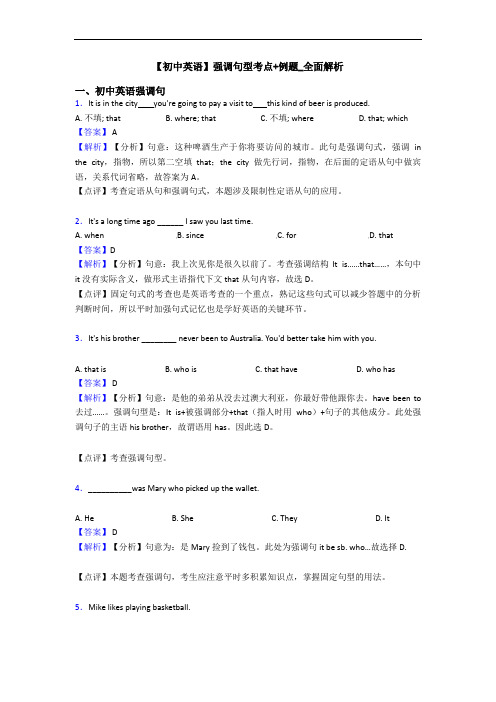
【初中英语】强调句型考点+例题_全面解析一、初中英语强调句1.It is in the city you're going to pay a visit to this kind of beer is produced.A. 不填; thatB. where; thatC. 不填; whereD. that; which 【答案】 A【解析】【分析】句意:这种啤酒生产于你将要访问的城市。
此句是强调句式,强调in the city,指物,所以第二空填that;the city做先行词,指物,在后面的定语从句中做宾语,关系代词省略,故答案为A。
【点评】考查定语从句和强调句式,本题涉及限制性定语从句的应用。
2.It's a long time ago ______ I saw you last time.A. whenB. sinceC. forD. that【答案】D【解析】【分析】句意:我上次见你是很久以前了。
考查强调结构It is……that……,本句中it没有实际含义,做形式主语指代下文that从句内容,故选D。
【点评】固定句式的考查也是英语考查的一个重点,熟记这些句式可以减少答题中的分析判断时间,所以平时加强句式记忆也是学好英语的关键环节。
3.It's his brother ________ never been to Australia. You'd better take him with you.A. that isB. who isC. that haveD. who has【答案】 D【解析】【分析】句意:是他的弟弟从没去过澳大利亚,你最好带他跟你去。
have been to 去过……。
强调句型是:It is+被强调部分+that(指人时用who)+句子的其他成分。
此处强调句子的主语his brother,故谓语用has。
因此选D。
【点评】考查强调句型。
高考英语强调句用法总结,必备!

高考英语强调句用法总结,必备!强调句是高中英语学习过程中常见的一种句型,也是英语学习的重点、难点。
强调句是用来表示强调说话人的意愿和情感。
它只是强调句子的某一个成分,通常强调主语、宾语或者是状语。
那么今天小编结合近几年来的高考题,对强调句的基本用法以及考点进行了全面的归纳和总结,希望对大家的学习能有所启发。
一、强调句基本句型1、强调句的陈述句句型为:It is /was+被强调的部分+that/who引导的从句+原句其他部分。
尼们可以看下面例句来体会理解:2、强调句的一般疑问句型:Is / Was +it+被强调的部分+that/ who/ whom引导的从句+原句其他的部分。
3、强调句的特殊疑问句型:特殊疑问词(When /Where/ Why/ Who/ What/ How )+is/ was +it +that从句+原句的其他部分。
二、需要注意的问题1、无论强调据说强调的主语是单数还是复数,强调句中所用的be动词始终都是is或者是was,如果强调的是将来或者是正在发生的事情或正在进行的动作的时候,只能用is;如果强调过去已经完成的就用was。
2、大家需要记住一点,强调句去掉了it is/ was…+that之后,对于句子的完整性不造成影响,这也是与其他句子区分有一个重要标志。
三、考点归纳1、主谓一致。
在强调主语的时候,that后的谓语动词要与被强调者保持是人称和数的一致,例如:It is I who am a teacher.2、连接词。
在强调状语的时候,无论被强调的部分是表示时间还是地点, 能不能用when或者where,连接词只能用that。
同时要注意与下列句型的区分:3、考查对“not…until…”进行强调,常会使用句型“It is / was… not …until…that…”这个强调句型是高考的高频考点,意思是“不是……而是……”。
4、考查与主语从句,状语从句和定语从句的辨析强调句很容易和名词从句这个句型混淆,如:It is clear (obvious, true, possible, certain…) that…大家要清楚这里的it是形式主语,真正的主语是that引导的主语从句。
英语强调句型考点+例题-全面解析

外研版英语强调句型考点+例题-全面解析一、初中英语强调句1.It is water, which seems so simple and common, ________ makes it possible for all living beings on this planet to survive and develop.A. whenB. whichC. thatD. where【答案】C【解析】【分析】句意:是看起来很简单很普通的水使地球上所有的生物都有可能生存和发展。
这是一个强调句型,其结构:It is/was+被强调部分+that/who+句子其它部分,故选C。
【点评】考查强调句型,掌握其结构:It is/was+被强调部分+that/who+句子其它部分。
2.— It was ___________ who helped us out of danger.— What brave and helpful children! We should learn from them.A. theyB. themC. theirD. theirs【答案】 A【解析】【分析】根据题干,这是一个强调句,强调主语!英语中为了表达的正式,这时应用主格的代词。
本句的意思是“就是他帮我们脱离的危险。
”所以本题选A。
【点评】对于强调句中强调主语时应注意,如果不加分析可能会选择them。
这在平时的学习中一定要注意分析。
3.She found her lost car._______ she had!A. What a good luckB. What good luckC. How good luckD. How good the luck【答案】A【解析】【分析】句意“她发现了她丢失的小汽车,她多么幸运啊。
”此处为强调句典型句型,这种句型中what+名词,how+形容词\副词,luck此处表示名词单数“一次好运”,what a good luck=how lucky。
强调句型辨析

强调句型辨析强调句型在英语写作中起着重要的作用,能够突出某一信息,增强表达的效果。
然而,在使用强调句型时,很多学习者容易混淆不同的句型,导致语意不清或语法错误。
本文将针对常见的强调句型进行辨析和用法介绍,以帮助读者正确运用强调句型,提升英语写作技巧。
一、强调句型一:It is/was + 被强调部分 + that/who/whom + 句子其他部分强调句型一常用于强调人或物。
在这种句型中,被强调部分通常是一个名词或代词,也可以是词组或从句。
请看以下例句:1. It was John who won the first prize in the competition.2. It is my grandmother's wisdom that I cherish the most.3. It was during the summer vacation that I met my best friend.在这种句型中,that/who/whom 引导的从句通常用来进一步说明被强调部分,并且不能省略。
二、强调句型二:What + be + 被强调部分 + 句子其他部分强调句型二常用于强调事物或情况。
被强调部分通常是一个名词或词组。
请看以下例句:1. What surprises me most is his sudden decision to quit his job.2. What I want to say is that we should all strive for our dreams.3. What matters most is your attitude towards life.在这种句型中,被强调部分是整个句子的主语或宾语。
三、强调句型三:强调副词only、even等的使用只有、仅仅、竟然等副词的使用能够加强对某一信息的强调。
请看以下例句:1. Only when you work hard can you achieve success.2. Even my grandmother, who is 80 years old, can use a computer.3. I never expected that he would be so rude to me.在以上例句中,only、even 等副词都起到了强调作用,突出了所强调的信息。
强调句型重点用法例析

解析:选A 被强调的是时间状语after he got what he had desired
2.强调句型用于强调一般疑问句。
形式:Is/Was it+被强调部分+that/who…?
例: Was it form the lake___ he often went fishing___ he saved the drowning girl?
–How was itthatyougot in touch withMr.Smith?你是怎么和Smith先生联系上的?
–Troughafriendofmine.通过一个朋友。
二、强调句型使用的场合
1.强调句型用于强调陈述句。
形式:It is/was + 被强调部分+ that/who…
例:(1)It was there, the police believe,___ she was able to activate the recorder she kept in her bag .
→Whowas it that yousawin thestreet yesterdayafternoon?
→Where wasit thatyousaw himyesterdayafternoon?
[例句2]
Idon’tknowwhenhe willcomeback.
→I don’t knowwhen itis that he will come back.(宾语从句疑问词后用陈述句语序)
强调句型重点用法例析
———————————————————————————————— 作者:
———————————————————————————————— 日期:
高中英语特殊句式之强调句

强调句型是高考范围的语法项目,更是命题者的青睐,下面结合几年的高考题作一阐述。
一、句型特征及含义It + be的适当形式+ 被强调部分+ that / who + 其他注:be前可加上may/might/must等情态动词。
It may be at the party that Tom knew her.It must be John that/who will take part in the contest on behalf of our class.翻译时常加上“正是…… ; 就是…… ”等字眼,以突出其强调的含义。
二、强调角度及运用1. 在强调句中含有not until 句型时,用下列句型:It was not until + 短语/句子+ that ….. that后的句子要用肯定句,且须用陈述语序。
①It was not until 250 years later that they formed a single state.②It was not until he realized it that I told him.③It was not until midnight they reached the camp site.A. thatB. whenC. whileD. as④It was not until this moment when I considered myself truly different that my writing acquired a voice. 正是当我考虑到自己真正与别人不同时,我才获得了写作的灵感。
⑤It was not until she took off her dark glasses that I recognized she was a famous film star.⑥It is ________that I left for Qingdao.A. until he came backB. not until he came backC. that he came backD. not that he came back (key: B)此题的命题构思是这样的:I didn’t leave for Qin gdao until he came. Not until he came did I leave for Qingdao.It is not until he came back that I left for Qingdao.2. 强调主语:①It’s actually the simpler uses of a camera phone ______ the most interesting. They could make photographers of us all!A. that areB. which areC. that isD. which is(主语是the simpler uses, 是复数,所以要特别小心。
浅析英语中的强调句型

浅析英语中的强调句型一、基本概念:当需要强调句子的某一部分(通常是主语、宾语、状语)时,能够把it当作先行词,用强调句结构“It is/was + 被强调部分+ that/who + 句子其余部分”,这个句式把整个句子分割成前后两个部分,使之各自有自己的谓语动词,中间由that或who连起来成为一个新句子。
二、强调句式:假设强调的主语部分是人,可用who来代替that。
如:1、I met Tom in the street yesterday.(1)强调主语:陈述式:It was I that/who met Tom in the street yesterday.一般疑问式:Was it you that/who met Tom in the street yesterday?特殊疑问式:Who was it that met Tom in the street yesterday?(2)强调宾语:陈述式:It was Tom that I met in the street yesterday.一般疑问式:Was it Tom that you met in the street yesterday?特殊疑问式:Whom was it that you met in the street yesterday?(3)强调地点状语:陈述式:It was in the street that I met Tom yesterday.一般疑问式:Was it in the street that you met Tom yesterday?特殊疑问式:Where was it that you met Tom yesterday?(4)强调时间状语:陈述式:It was yesterday that I met Tom in the street.一般疑问式:Was it yesterday that you met Tom in the street?特殊疑问式:When was it that you met Tom in the street?2、He didn’t come to school this morning because he was ill.强调原因状语:It was because he was ill that he didn’t come to school this morning.Was it because he was ill that he didn’t come to school thi s morning?Why was it that he did n’t come to school this morning?3、She caught up with her classmates by making great efforts.强调方式状语:It was by making great efforts that she caught up with her classmates.Was it by making great efforts that she caught up with her classmates?How was it that she caught up with her classmates?三、“It is/was + 被强调部分+ that/who + 句子其余部分”结构不能强调谓语,假设需要强调谓语,用助动词do, did, does + 动词原形,且只限于祈使句和肯定的陈述句。
强调句型考点+例题_全面解析

强调句型考点+例题_全面解析一、初中英语强调句1.It was back home after the experiment.A. not until midnight did he goB. until midnight that he didn't goC. not until midnight that he wentD. until midnight when he didn't go【答案】C【解析】【分析】句意:直到半夜实验后他才回家。
not until的强调句必须写成it was/is not until +陈述语序。
所以选C。
【点评】考查强调句,本题涉及not until的强调句型。
2.— It was ___________ who helped us out of danger.— What brave and helpful children! We should learn from them.A. theyB. themC. theirD. theirs【答案】 A【解析】【分析】根据题干,这是一个强调句,强调主语!英语中为了表达的正式,这时应用主格的代词。
本句的意思是“就是他帮我们脱离的危险。
”所以本题选A。
【点评】对于强调句中强调主语时应注意,如果不加分析可能会选择them。
这在平时的学习中一定要注意分析。
3.I _____ you can finish the exam in two hours.A. does believeB. do believeC. did believedD. do believed【答案】 B【解析】【分析】句意:—我确实相信两个小时内能完成考试。
这里用来强调,在谓语动词前加助动词do表示强调。
句子的主语是第一人称,所以位于动词不能用单数,故排除A;did后用动词原形;do后用动词原形,故选B。
【点评】本题考查强调句型。
英语强调句的用法剖析
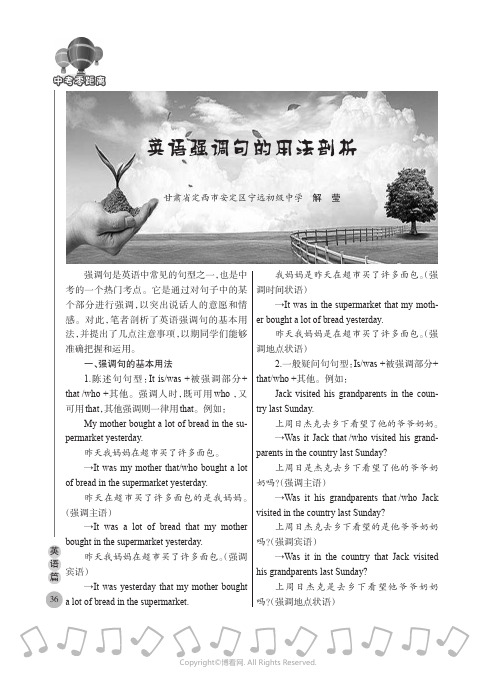
英语篇强调句是英语中常见的句型之一,也是中考的一个热门考点。
它是通过对句子中的某个部分进行强调,以突出说话人的意愿和情感。
对此,笔者剖析了英语强调句的基本用法,并提出了几点注意事项,以期同学们能够准确把握和运用。
一、强调句的基本用法1.陈述句句型:It is/was+被强调部分+that/who+其他。
强调人时,既可用who,又可用that,其他强调则一律用that。
例如:My mother bought a lot of bread in the su-permarket yesterday.昨天我妈妈在超市买了许多面包。
→It was my mother that/who bought a lotof bread in the supermarket yesterday.昨天在超市买了许多面包的是我妈妈。
(强调主语)→It was a lot of bread that my motherbought in the supermarket yesterday.昨天我妈妈在超市买了许多面包。
(强调宾语)→It was yesterday that my mother boughta lot of bread in the supermarket.我妈妈是昨天在超市买了许多面包。
(强调时间状语)→It was in the supermarket that my moth-er bought a lot of bread yesterday.昨天我妈妈是在超市买了许多面包。
(强调地点状语)2.一般疑问句句型:Is/was+被强调部分+that/who+其他。
例如:Jack visited his grandparents in the coun-try last Sunday.上周日杰克去乡下看望了他的爷爷奶奶。
→Was it Jack that/who visited his grand-parents in the country last Sunday?上周日是杰克去乡下看望了他的爷爷奶奶吗?(强调主语)→Was it his grandparents that/who Jackvisited in the country last Sunday?上周日杰克去乡下看望的是他爷爷奶奶吗?(强调宾语)→Was it in the country that Jack visitedhis grandparents last Sunday?上周日杰克是去乡下看望他爷爷奶奶吗?(强调地点状语)英语强调句的用法剖析甘肃省定西市安定区宁远初级中学解莹中考零距离36。
中考英语语法学习之强调句用法与高频考点

中考英语语法学习之强调句用法与高频考点一、强调句型为了强调句子的某一成分(通常是主语、宾语、或状语),常用强调句型:It is (was) +被强调部分+that(who)…表示强调的 it 在句子中作主句的主语;被强调部分可以是主语,宾语,表语或状语;强调的主语如果是人,that和who 都可用。
如:Last night I saw a film in the Youth Palace.强调主语:It was I that (or: who) saw a film in the Youth Palace last night.强调宾语:It was a film that I saw in the Youth Palace last night.强调地点状语:It was in the Youth Palace that I saw a film last night.强调时间状语:It was last night that I saw a film in the Youth Palace.另外,还要注意下面几点:1)在强调主语时,that 后的谓语动词要与被强调者保持人称和数的一致。
如:It is I who am a teacher.2)即使被强调的主语是复数,主句中的谓语动词也用单数。
如:It is they who often help me with my lessons.3)在强调时间、地点、原因或方式状语时,不能用when,where,why或 how ,而要用that 。
如:It was because her mother was ill that she didn't go with us.It was only when I reread his poems recently that I began to appreciate their beauty.It was the house that the murder happened.4)在强调not … until 结构中由 until 短语(或从句)表示的时间状语时,要用固定的强调句型:It is(was) not until ...that... 注意此时原句的not…until要变成not until ,that 从句中的谓语动词要用肯定式。
强调句型

“It is/was + 被强调部分 + that/who + 句子其他部分”是强调句型。
除了谓语动词不能强调外,句子中其它成分都可以用该句型加以强调。
一、强调句型的功能:1. 强调主语被强调的主语是人时,可用it is/was ... that/ who ...,但如果被强调的部分既包括人又包括物,只能用that。
It is Wei Fang who has broken the record. 是魏方打破了纪录。
2. 强调宾语It was me that she helped yesterday. 昨天她帮助的人是我。
3. 强调宾语补足语It was chairman of the meeting that we elected him. 我们选他是做会议的主席。
4. 强调状语英语中的状语种类很多,一般都可以用it is / was ... that ...来强调。
①时间状语It was at the age of 5 that he left his hometown for Taiwan.注意:如果强调由not…until/till 引导的时间状语时,要否定前移。
如:It was not until after liberation that he returned to his hometown.②频率状语It is once in a while that he comes to see me.③地点状语It was in this street that the car accident happened yesterday.④方式状语It was by turns that they took care of their sick mother.⑤目的状语It was to catch the early bus that he got up early.⑥原因状语It was because the water had risen that they could not cross the river.二、强调句的一般疑问句和特殊疑问句1. 强调句的一般疑问句句型是:Is/Was + it + that +句子其它成分。
高中英语:强调句专项讲解
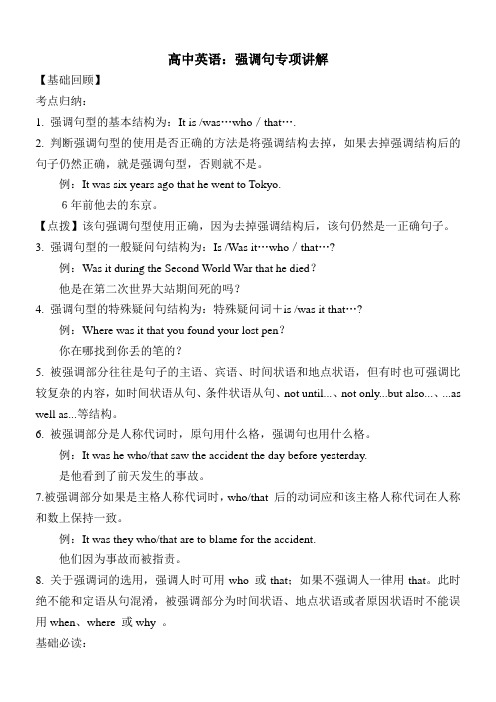
高中英语:强调句专项讲解【基础回顾】考点归纳:1. 强调句型的基本结构为:It is /was…who/that….2. 判断强调句型的使用是否正确的方法是将强调结构去掉,如果去掉强调结构后的句子仍然正确,就是强调句型,否则就不是。
例:It was six years ago that he went to Tokyo.6年前他去的东京。
【点拨】该句强调句型使用正确,因为去掉强调结构后,该句仍然是一正确句子。
3. 强调句型的一般疑问句结构为:Is /Was it…who/that…?例:Was it during the Second World War that he died?他是在第二次世界大站期间死的吗?4. 强调句型的特殊疑问句结构为:特殊疑问词+is /was it that…?例:Where was it that you found your lost pen?你在哪找到你丢的笔的?5. 被强调部分往往是句子的主语、宾语、时间状语和地点状语,但有时也可强调比较复杂的内容,如时间状语从句、条件状语从句、not until...、not only...but also...、...as well as...等结构。
6. 被强调部分是人称代词时,原句用什么格,强调句也用什么格。
例:It was he who/that saw the accident the day before yesterday.是他看到了前天发生的事故。
7.被强调部分如果是主格人称代词时,who/that 后的动词应和该主格人称代词在人称和数上保持一致。
例:It was they who/that are to blame for the accident.他们因为事故而被指责。
8. 关于强调词的选用,强调人时可用who 或that;如果不强调人一律用that。
此时绝不能和定语从句混淆,被强调部分为时间状语、地点状语或者原因状语时不能误用when、where 或why 。
强调句型
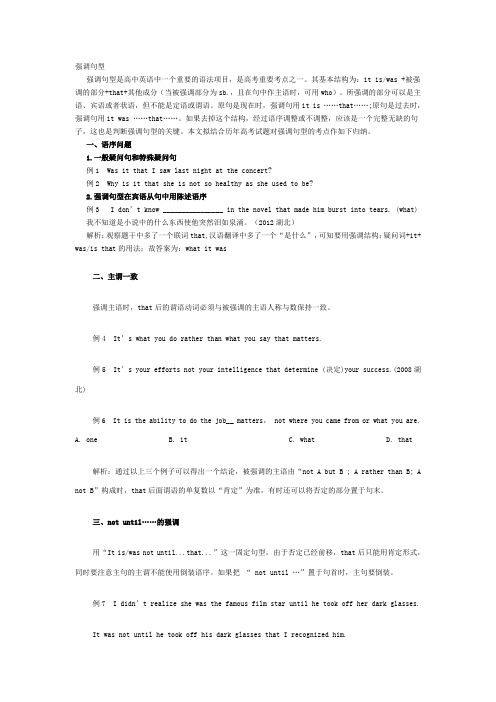
强调句型强调句型是高中英语中一个重要的语法项目,是高考重要考点之一。
其基本结构为:it is/was +被强调的部分+that+其他成分(当被强调部分为sb.,且在句中作主语时,可用who)。
所强调的部分可以是主语、宾语或者状语,但不能是定语或谓语。
原句是现在时,强调句用it is ……that……;原句是过去时,强调句用it was ……that……。
如果去掉这个结构,经过语序调整或不调整,应该是一个完整无缺的句子,这也是判断强调句型的关键。
本文拟结合历年高考试题对强调句型的考点作如下归纳。
一、语序问题1.一般疑问句和特殊疑问句例1 Was it that I saw last night at the concert?例2 Why is it that she is not so healthy as she used to be?2.强调句型在宾语从句中用陈述语序例3 I don’t know ________________ in the novel that made him burst into tears. (what)我不知道是小说中的什么东西使他突然泪如泉涌。
(2012湖北)解析:观察题干中多了一个联词that,汉语翻译中多了一个“是什么”,可知要用强调结构:疑问词+it+ was/is that的用法;故答案为:what it was二、主谓一致强调主语时,that后的谓语动词必须与被强调的主语人称与数保持一致。
例4 It’s what you do rather than what you say that matters.例5 It’s your efforts not your intelligence that determine (决定)your success.(2008湖北)例6 It is the ability to do the job__ matters, not where you came from or what you are.A. oneB. itC. whatD. that解析:通过以上三个例子可以得出一个结论,被强调的主语由“not A but B ; A rather than B; A not B”构成时,that后面谓语的单复数以“肯定”为准,有时还可以将否定的部分置于句末。
高考英语语法之强调句型一、强调句...
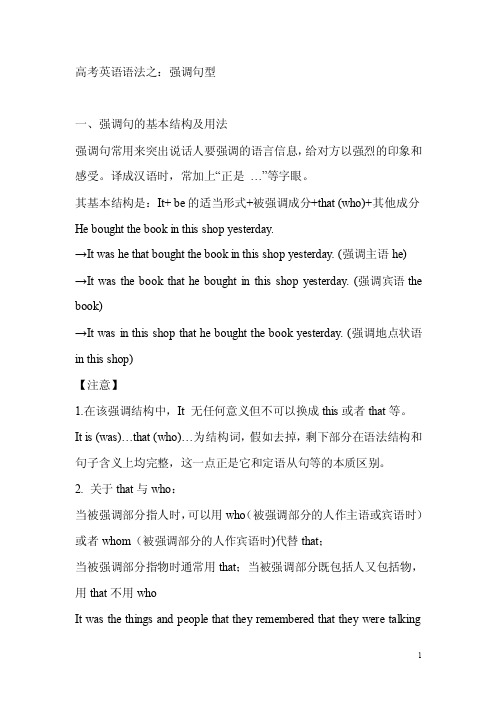
高考英语语法之:强调句型一、强调句的基本结构及用法强调句常用来突出说话人要强调的语言信息,给对方以强烈的印象和感受。
译成汉语时,常加上“正是…”等字眼。
其基本结构是:It+ be的适当形式+被强调成分+that (who)+其他成分He bought the book in this shop yesterday.→It was he that bought the book in this shop yesterday. (强调主语he)→It was the book that he bought in this shop yesterday. (强调宾语the book)→It was in this shop that he bought the book yesterday. (强调地点状语in this shop)【注意】1.在该强调结构中,It 无任何意义但不可以换成this或者that等。
I t is (was)…that (who)…为结构词,假如去掉,剩下部分在语法结构和句子含义上均完整,这一点正是它和定语从句等的本质区别。
2. 关于that与who:当被强调部分指人时,可以用who(被强调部分的人作主语或宾语时)或者whom(被强调部分的人作宾语时)代替that;当被强调部分指物时通常用that;当被强调部分既包括人又包括物,用that不用whoIt was the things and people that they remembered that they were talkingabout.当被强调部分是代词时,用who不用that。
当强调时间或地点或原因状语时,不能用when / where /why代that(尤其是当这些状语为介词短语时)。
1)It was only when I reread his poems recently ____ I began to appreciate their beauty.A. untilB. thatC. whenD. so2)It was in Qingdao _____ I saw the sea for the first time.A. whatB. thatC. whenD. which3)It was because of bad weather ____ the football match had to be put off.A. soB. so thatC. whyD. that如果被强调的成分有同位语,同位语也应提前。
强调句型总结

强调句型总结1、当强调谓语动词时,用do 或者did 强调。
did与过去式连用,do与一般时连用,只有这两种形式。
例:他昨天的确写完了作业。
He did have homework done.这里用did强调谓语动词have,表示他的确做了“完成作业"这个动作。
have sth done这里表示使某事完成2、only+状语倒装很明显,这个用法已经说明了,当强调状语时使用only+状语倒装。
且注意哦,只有only+状语才引起部分倒装,only+其他成分不倒装。
例:只有他打开窗户才能呼吸到清新的空气。
分析:呼吸到清新的空气的条件是什么?他打开窗户。
因此“他打开窗户”是条件状语。
因此强调状语,使用用only+状语倒装因此是:Only if he opens the window can he breathe clean air.所谓的部分倒装,或称为半倒装,就是助动词或者情态动词提前,如can、should等不倒装的情况:only后加的不是状语如:只有他没写作业。
Only he did not have the homework done.很明显,他是主语,不是状语,因此不倒装。
再重复一遍哦,很重要,only+状语才倒装,强调状语。
3、强调主语,且主语句子都较短,使用强调句型it is /it was that.例:正是这些人给了我们支持(back)It is these people who back us.我们分析一下,这句话强调的内容是“这些人”,强调是主语,而且主语和整个句子都比较短,所以用强调句型it is /it was that进行强调。
4、句子短,且没有小分句,强调宾语或表语,用主语从句强调例:教育的目的正是要培养学生的责任意识What education needs to develop is students’ sense of responsibility.分析:“正是”后面接的就是强调内容,所以强调内容为“学生的责任意识”。
强调句型用法及注意事项

强调句型用法及注意事项一、强调句型的用法在英语中,我们常用It is/was… who/that结构来突出强调句子的某一成分(一般是句子中主语,宾语或状语)。
在这个句型中,it没有词汇意义,只是引出被强调的成分。
如果被强调的成分是表示人的词,用who或that来连接都可以。
如果是其它成分,则一律用that来连接。
It was in the park that I met my old teacher yesterday.(强调地点状语)It was yesterday that I met my old teacher in the park.(强调时间状语)It was my old teacher that I met in the park yesterday.(强调宾语)It is Mr Smith who/that thinks Tom is a clever boy.(强调主语)二、使用本句型的几个注意事项1.被强调成分是主语,who/that之后的谓语动词应该在人称和数上与原句中的主语保持一致。
E.g. It is I who am right.It is he who is wrong.It is the students who are lovely.2.即使被强调成分是句子中的时间状语,地点状语,原因状语等,也不能用when,where, because,要用that。
E.g. It was after the war was over that Einstein was able to come back to his research work again.It was in front of the bank that the old lady was robbed.It was because of the heavy rain that he came late.3.如果被强调的成分有同位语,同位语也应提前。
- 1、下载文档前请自行甄别文档内容的完整性,平台不提供额外的编辑、内容补充、找答案等附加服务。
- 2、"仅部分预览"的文档,不可在线预览部分如存在完整性等问题,可反馈申请退款(可完整预览的文档不适用该条件!)。
- 3、如文档侵犯您的权益,请联系客服反馈,我们会尽快为您处理(人工客服工作时间:9:00-18:30)。
强调句型重点用法例析巩勃英语中“It is/was +被强调部分+who/that+其它”是强调句型的基本构成。
这种结构在中学英语课本中频频出现,引起高考命题者的格外关注。
强调句的基本句型是:“It is/was+被强调部分+that/who从句。
”可强调的句子成分通常为主语,状语,宾语等,不能用来强调谓语动词, 表语(主语补语), 定语,让步状语, 条件状语等。
被强调部分可以是单词,短语,也可以是从句。
一、具体用法:强调句的基本构成:It is/was + 被强调的部分+ who(主要指人时)/that + 其余部分[注意1]这种结构可以强调句子的主语、宾语、状语(包括时间,地点,方式,原因等),但是不能强调谓语动词。
原句的谓语动词如果是现在或将来时态,用It is…that/who….;原句的谓语动词如果是过去时态,用It was…that/who….;强调时间、地点、原因或方式时不要用when, where或how, 必须用that。
[例句1]I saw him in the street yesterday afternoon.→It was I who saw him in the street yesterday afternoon.(强调主语)→It was in the street that I saw him yesterday afternoon.(强调地点状语)→It was yesterday afternoon that I saw him in the street.(强调时间状语)→It was him that/who I saw in the street yesterday afternoon.(强调宾语)[例句2]He d idn’t go to bed until his mother came back.→It was not until his mother came back that he went to bed.He didn’t do his homework until his father came back from work.→It wasn’t until his father came back from work that he did his homework.[例句3]Only when you nearly lose someone do you fully realize how much you value him.→It is only when you nearly lose someone that you fully realize how much you value him.只有你快要失去某个人时,你才意识到你是多么尊重他。
[例句4]I was late again because the traffic was very heavy during the rush hour.→It was because the traffic was very heavy during the rush hour that I was late again.强调句中只能强调由because引导的原因状语从句,because不能换成since, as, for, now that 等。
[注意2]强调句的疑问结构一般疑问句Is / Was it +被强调部分+who / that …?特殊疑问句特殊疑问词+is /was +it +who / tha t…?What is/was it that…?Who is/was it that…?When is/was it that…?Where is/was it that…?Why is/was it that…?How is/was it that…?[例句1]I saw him in the street yesterday afternoon.→When was it th at you saw him in the street?→Who was it that you saw in the street yesterday afternoon?→Where was it that you saw him yesterday afternoon?[例句2]I don’t know when he will come back.→I don’t know when it is that he will come back.(宾语从句疑问词后用陈述句语序)–How was it that you got in touch with Mr. Smith? 你是怎么和Smith先生联系上的?–Trough a friend of mine. 通过一个朋友。
二、强调句型使用的场合1.强调句型用于强调陈述句。
形式:It is/was + 被强调部分+ that/who…例:(1)It was there, the police believe,___ she was able to activate the recorder she kept in her bag .A. untilB. whichC. thatD. when解析:选C 被强调部分为地点状语there,the police believe为插入语(2)It was after he got what he had desired___ he realized it was not so important.A. thatB. whenC. sinceD. as解析:选A 被强调的是时间状语after he got what he had desired2.强调句型用于强调一般疑问句。
形式:Is/Was it+被强调部分+that/who…?例: Was it form the lake___ he often went fishing___ he saved the drowning girl?A. that; thatB. where; whereC. where;thatD. that; where解析:选C 解答此题关键是能够对句型进行正确的分析和判断。
本题题干为一个强调句式,it was +被强调部分+that/who,lake后面是个定语从句,由关系副词where引导,第二空才是强调句中的that。
注意:如果该句型用于宾语从句中,应使用陈述语序。
3.强调句型用于强调特殊疑问句。
形式:疑问词(Wh-)+ is/was it that+其他部分I really don’t know ___ I had my money stolen.A. when was it thatB. that it was whenC. where it was thatD. it was where that解析:选C 强调句作know的宾语,语序应为陈述句语序,被强调部分为where,但是强调句为宾语从句时,这类wh-连接代词或副词常置于it之前,作宾语从句的连接词。
注意:如果该句型用于宾语从句中,应使用陈述语序。
4.强调句型用于强调not…until…句型形式:It is/was not until +被强调部分+that+其他成分例:(1) It was not until she got home ___Jennifer realised she had lost her keys.A. whenB.thatC.whereD.before 、解析:选B 考查强调句中对not until的强调;是否能辨析出引导词that.(2).___the catastrophe happened that the local government realized the importance of substantial development.A. It was untilB. Not untilC. UntilD.It was not until解析:选D。
考查强调句中not until的用法.考查了 It was not until the catastrophe happened that .5.变式强调句型变式1 It must /may/might/ be+被强调部分+that …变式2 It must/may/might have been+被强调部分+that…变式3 It can’t/couldn’t be + 被强调部分+that…变式4 Could/can it be +被强调部分+that…如:It might be his father that you’ve been thinking of.It must have been his brother that you saw.It can’t be your book that he is reading.Could it be Tom that is making the noise?6.几种特殊的强调句型的理解与使用1)It’s…, not… who …是……而不是……,例如:It is you, not he, who/that are to meet him at the airport.2)It is/was not… but… that…不是……而是……, that后的动词应与but后的名词或代词保持人称和数的一致,例如:It is not who is right but what is right____ is of importance.A.whichB. itC. thatD. this 答案为 C3) It is /was … not… that, 或It is/was… that…, not…,,是……而不是……, that 后的动词应与not前的名词或代词保持一致。
例如:It is the ability to do the job that matters, not where you come from or what you are.It is the way you speak not what you say that matters.4)It is /was… rather than… that, 是……而不是……,that后的动词应与rather than前的名词或代词保持人称和数的一致。
例如:It is the prevention of disease rather than its successful treatment that led to the rapid increase of the world’s population.7. 强调句型中套用定语从句形式:It is/was + 被强调部分+关系代词/副词+定语从句+that+其他成分例如:It was the training ____he had as a young man____ made him such a good engineer.A. what; thatB. that; whatC. that ; whichD. which; that该题中第一空是定语从句,the training作了he had的宾语,所以选用which;第二空是It was…+被强调部分(the training)+that…的强调句型。
